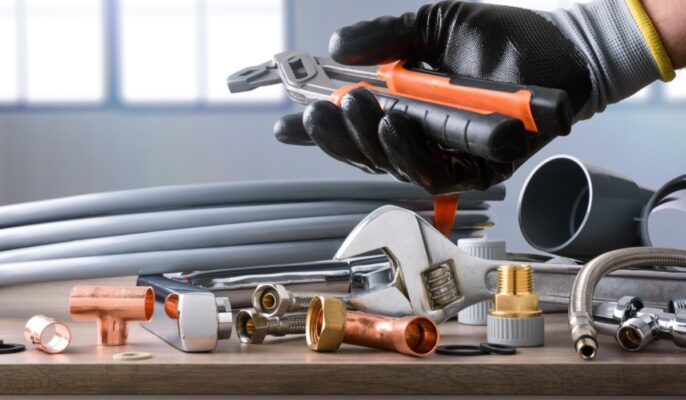As the world grows more conscious of climate change and the need for sustainability, many homeowners and building professionals are taking a closer look at how everyday systems—like plumbing—affect the environment. While plumbing may not be the first thing that comes to mind when thinking about eco-conscious decisions, the materials used, water efficiency of fixtures, and energy consumed by plumbing systems can all leave a significant environmental footprint. Understanding the environmental impact of plumbing choices is essential in creating greener homes and buildings.
Materials Matter More Than You Think
 The environmental impact of plumbing begins with the materials selected for pipes and fixtures. Traditionally, plumbing systems have relied heavily on copper and PVC (polyvinyl chloride) piping. Copper, although durable and recyclable, requires intensive mining and manufacturing processes that contribute to greenhouse gas emissions and habitat destruction. On the other hand, PVC is inexpensive and easy to install, but its production releases harmful dioxins and other toxic chemicals into the environment.
The environmental impact of plumbing begins with the materials selected for pipes and fixtures. Traditionally, plumbing systems have relied heavily on copper and PVC (polyvinyl chloride) piping. Copper, although durable and recyclable, requires intensive mining and manufacturing processes that contribute to greenhouse gas emissions and habitat destruction. On the other hand, PVC is inexpensive and easy to install, but its production releases harmful dioxins and other toxic chemicals into the environment.
Sustainable alternatives such as PEX (cross-linked polyethylene) have emerged as eco-friendlier options. PEX piping is flexible, requires fewer fittings, and is energy-efficient to manufacture. Stainless steel and recycled copper are also becoming more popular in green construction due to their long life cycles and reduced environmental costs when recycled properly. Choosing materials with low embodied energy and high recyclability plays a crucial role in reducing the overall environmental burden of plumbing systems.
Water Efficiency Is Key to Conservation
One of the most direct ways plumbing impacts the environment is through water consumption. Traditional plumbing fixtures such as toilets, faucets, and showerheads often use more water than necessary, leading to unnecessary strain on freshwater resources. This not only depletes water sources but also increases the energy needed to pump, treat, and heat water.
Modern plumbing systems offer numerous opportunities to conserve water. Low-flow fixtures are designed to use significantly less water without sacrificing performance. Dual-flush toilets, aerated faucets, and water-saving showerheads can reduce water consumption in homes by thousands of gallons per year. Additionally, greywater recycling systems and rainwater harvesting setups allow for reusing water for non-potable purposes like irrigation and toilet flushing, further minimizing waste and preserving fresh water.
Energy Use and Its Hidden Environmental Costs
While the visible function of plumbing is to deliver and remove water, the hidden energy costs associated with these systems are substantial. Heating water accounts for a considerable portion of household energy use. Inefficient water heaters, long piping systems, and poor insulation contribute to energy waste and higher carbon emissions.
Switching to energy-efficient water heaters such as tankless or solar water heaters can drastically reduce energy consumption. Tankless systems provide hot water on demand, eliminating standby heat loss associated with traditional water heaters. Solar water heaters harness renewable energy from the sun and are especially effective in sunny regions.
Insulating hot water pipes and placing water heaters closer to points of use can also reduce heat loss and lower energy bills. Making informed decisions about water heating and delivery systems helps decrease fossil fuel reliance and supports long-term environmental sustainability.
The Role of Plumbing in Wastewater Management
Once water has been used, it becomes wastewater, and how this wastewater is managed has a direct environmental impact. Conventional plumbing systems often direct all wastewater into municipal sewer systems, requiring significant energy and chemical treatment before it can be safely released into the environment.
In contrast, sustainable plumbing practices aim to minimize the load on wastewater treatment facilities. Composting toilets, greywater systems, and permeable drainage designs help reduce the volume of wastewater requiring treatment. By separating blackwater (sewage) from greywater (wastewater from sinks, showers, and appliances), it becomes possible to reuse some of this water and lessen the overall treatment burden.
Properly maintained septic systems also play an important role in areas without centralized sewer infrastructure. Ensuring these systems are functioning correctly helps prevent harmful leaks and contamination of soil and groundwater.
Smart Technology and Plumbing Efficiency
The rise of smart home technology has extended into the realm of plumbing, providing new ways to monitor and control water usage. Smart leak detectors, for instance, can alert homeowners to leaks before they cause major water damage or waste. Smart faucets and irrigation systems can be programmed to operate at optimal times and levels, further reducing water and energy usage.
Home automation systems that track water usage patterns can provide insights into consumption and highlight areas where improvements are needed. This type of data-driven approach empowers homeowners to make more sustainable choices and reduce their environmental footprint over time.
Plumbing and Building Certifications
Choosing environmentally friendly plumbing solutions can also contribute to green building certifications such as LEED (Leadership in Energy and Environmental Design), WELL Building Standard, and BREEAM. These certifications encourage builders and homeowners to incorporate sustainable practices in all areas of construction and renovation, including plumbing.
Adhering to certification standards often requires using fixtures that meet water efficiency benchmarks, installing renewable energy water heating systems, and implementing effective wastewater treatment solutions. These choices not only reduce environmental impact but can also increase property value and attract eco-conscious buyers or tenants.

The Long-Term Benefits of Green Plumbing
While eco-friendly plumbing choices may come with higher upfront costs, they often lead to long-term savings and environmental benefits. Reduced water and energy bills, fewer repairs, and a smaller carbon footprint make sustainable plumbing a wise investment. Moreover, as environmental regulations tighten and consumer expectations shift, green plumbing systems are becoming the new standard in modern construction.
Incorporating sustainability into plumbing design is not just about reducing harm—it’s about actively contributing to a healthier planet. By rethinking traditional practices and embracing new technologies and materials, homeowners and professionals can make impactful choices that support long-term ecological balance.